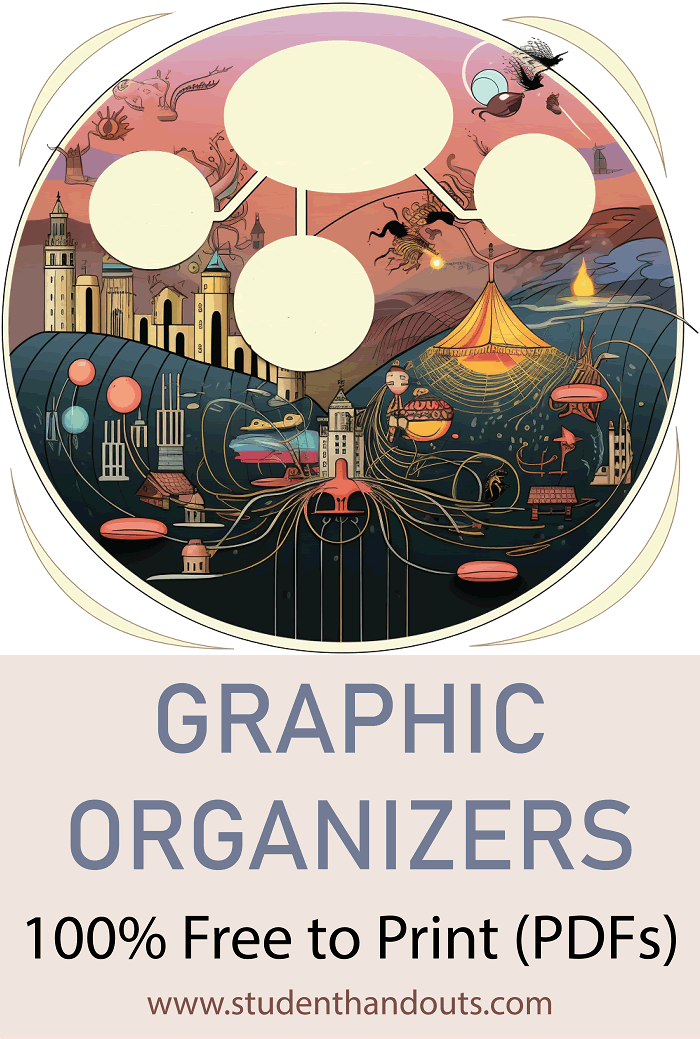| www.studenthandouts.com > Graphic Organizers |
 |
 |
 |
 |
 |
|
Graphic organizers are highly useful tools in education for several reasons.
Visual Representation: Graphic organizers visually represent information, making it easier for students to see relationships, connections, and hierarchies within a subject or topic. This visual format helps learners process complex information more effectively.  Organization and Structure: Graphic organizers provide a clear organizational structure for content. They help students break down information into manageable chunks, which makes it easier to understand and remember.
Organization and Structure: Graphic organizers provide a clear organizational structure for content. They help students break down information into manageable chunks, which makes it easier to understand and remember. Enhanced Comprehension: By presenting information in a structured and visual manner, graphic organizers enhance comprehension. Students can see the main ideas, supporting details, and how they relate to each other, leading to a deeper understanding of the subject matter. Critical Thinking: Using graphic organizers requires students to think critically about the material they are studying. They must analyze, categorize, and synthesize information, promoting higher-order thinking skills. Active Engagement: Graphic organizers engage students actively in the learning process. Instead of passively absorbing information, students interact with the material, which can improve retention and recall. Differentiation: Graphic organizers can be tailored to suit various learning styles and abilities. Educators can modify them to meet the needs of different students, including those with visual or kinesthetic learning preferences or special needs. Note-taking Aid: Graphic organizers are excellent tools for note-taking during lectures or while reading. They encourage students to summarize information concisely, helping them distill key concepts and important details. Memory Enhancement: The visual and structured nature of graphic organizers can aid memory retention. Students are more likely to remember information presented in a well-organized and visually appealing format. Writing Support: Graphic organizers can serve as prewriting tools for essays and reports. They help students brainstorm ideas, outline arguments, and plan the structure of their written work, making the writing process more manageable. Effective Communication: Graphic organizers can be used to help students communicate their thoughts and ideas more effectively. They can be valuable tools for organizing and presenting information in presentations or projects. Problem Solving: Graphic organizers can be adapted for problem-solving tasks. They assist students in breaking down complex problems into smaller, more manageable parts, facilitating the development of strategies and solutions. Transferable Skills: Skills acquired through the use of graphic organizers, such as critical thinking, organization, and effective communication, are transferable to various academic subjects and real-life situations. Metacognition: Using graphic organizers encourages metacognitio--the process of thinking about one's own thinking. Students reflect on how they organize and understand information, which can lead to improved self-awareness and learning strategies. Accessible Learning: Graphic organizers can be used to support diverse learners, including English language learners and students with learning disabilities. They provide a structured framework that can make content more accessible. Graphic organizers are versatile tools that promote effective learning, enhance comprehension, and develop critical thinking skills. They can be applied across a wide range of subjects and grade levels, making them valuable assets in the educational toolkit. |
| www.studenthandouts.com > Graphic Organizers |






